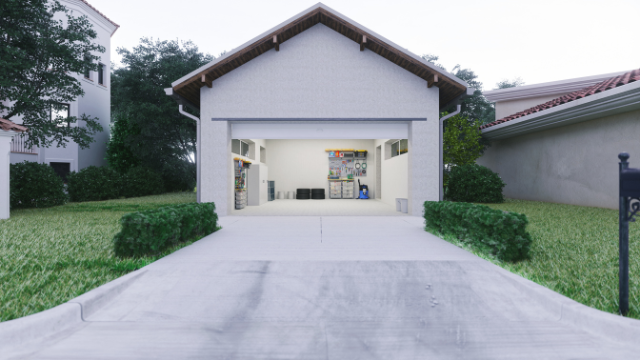Do you ever wonder how garage doors work? Well, you’re in the right place! In this article, we will explore the ins and outs of garage door mechanics. From the different types of garage doors to the components that make them function, we’ll cover it all. You’ll also learn about the crucial role of garage door springs and tracks, as well as the inner workings of garage door openers. Get ready to dive into the fascinating world of garage doors!
Types of Garage Doors
When choosing a garage door, consider the different types available to meet your specific needs and preferences. There are several materials to choose from, each with their own pros and cons. Steel is a popular choice due to its durability and low maintenance requirements. It is also available in a variety of styles and finishes to complement any home. However, steel doors can be prone to dents and may require insulation to prevent heat loss.
Another option is wood, which offers a classic and natural look. Wood doors can be customized and painted to match your home’s exterior. However, they require regular maintenance to prevent warping or rotting, and they can be more expensive than other materials.
For a more budget-friendly option, consider aluminum doors. They are lightweight and resistant to rust, making them a great choice for coastal areas. However, they may dent easily and lack insulation properties.
Choosing the right size and style of garage door is also important. Measure the opening of your garage to ensure a proper fit. Consider the architectural style of your home and choose a door that complements it. Traditional raised panel doors are versatile and suit many homes, while contemporary designs offer a sleek and modern look. Ultimately, select a garage door that meets your functional and aesthetic needs.
Components of a Garage Door
One important component of a garage door is the springs. These springs are responsible for counterbalancing the weight of the door, making it easier to open and close. There are two main types of springs used in garage doors: torsion springs and extension springs. Torsion springs are typically mounted above the door and use torque to lift the door, while extension springs are usually located on either side of the door and stretch to provide the necessary force.
In addition to springs, another crucial component of a garage door is the opener. The opener is an electric motor that is responsible for lifting and lowering the door. It is usually installed on the ceiling of the garage and connected to the door with a system of pulleys and cables. The opener can be operated with a remote control or a wall-mounted switch.
Lastly, garage door insulation is an important component for maintaining the temperature inside the garage. Insulated garage doors help to keep the garage cooler in the summer and warmer in the winter, making it more energy efficient. Insulation is typically made of materials such as polystyrene or polyurethane and is installed between the layers of the door.
Understanding the components of a garage door is essential for proper garage door installation and maintenance. By knowing how these components work together, you can ensure the smooth operation and longevity of your garage door.
How Garage Door Springs Work
To understand how garage door springs work, you need to know their crucial role in counterbalancing the weight of the door. Garage door springs are responsible for making it easier to open and close your garage door, as well as ensuring its safe operation. These springs work by storing and releasing energy to help lift and lower the door smoothly.
There are two types of garage door springs: torsion springs and extension springs. Torsion springs are mounted above the door, while extension springs are typically located on either side of the door. Both types of springs work in similar ways, but they have different configurations.
Here is a table that compares the two types of garage door springs:
| Torsion Springs | Extension Springs |
|---|---|
| Mounted above the door | Located on either side of the door |
| Twist and coil to store energy | Stretch and contract to store energy |
| Can be adjusted for different door weights | Require precise measurements for proper balance |
| Generally last longer than extension springs | May need more frequent replacement |
It is important to note that garage door spring repair should always be done by a professional, as these springs are under a significant amount of tension and can be dangerous if mishandled. Additionally, the importance of garage door insulation cannot be overstated, as it helps regulate temperature, reduces noise, and improves energy efficiency.
The Role of Garage Door Tracks
Garage door tracks play a crucial role in guiding the smooth movement of the door as you open and close it. These tracks are typically made of metal and are installed on both sides of the garage door. Here are three important things you should know about garage door tracks:
- Proper maintenance is key: To ensure the tracks function properly, regular maintenance is necessary. Over time, debris and dirt can accumulate in the tracks, causing them to become clogged. It is important to clean the tracks periodically to prevent any obstruction in the door’s movement. Additionally, lubricating the tracks with a silicone-based lubricant can help reduce friction and ensure smooth operation.
- Track alignment is crucial: If the tracks become misaligned, it can lead to issues with the garage door’s movement. You may notice that the door becomes difficult to open or close, or it may get stuck halfway. In such cases, troubleshooting the garage door track alignment is necessary. This involves checking if the tracks are parallel and adjusting them if needed. It is important to ensure that the tracks are properly aligned to prevent further damage to the door or the tracks themselves.
- Seek professional help when needed: If you encounter any issues with your garage door tracks that you are unable to resolve, it is recommended to seek professional help. Garage door technicians have the expertise and tools to properly diagnose and fix any problems with the tracks. They can also provide guidance on proper garage door track maintenance to ensure the longevity of your door system.
Understanding Garage Door Openers
When it comes to operating your garage door, understanding how garage door openers work is essential. Garage door openers are motorized devices that allow you to open and close your garage door with ease. The installation of a garage door opener typically involves mounting the opener to the ceiling of your garage and attaching it to the door by means of a trolley or arm. The opener is then connected to a power source and controlled by a remote or a wall-mounted switch.
Garage door openers operate using a motor that drives a chain, belt, or screw mechanism. When you press the button on your remote or wall switch, the motor is activated, causing the mechanism to move and the door to open or close. Safety sensors are also installed near the bottom of the door to detect any obstructions and prevent the door from closing on them.
Troubleshooting garage door opener issues can often be done by checking the power source, ensuring the safety sensors are aligned and clean, and inspecting the opener for any loose or damaged parts. If you are unable to diagnose or fix the problem yourself, it is recommended to seek professional assistance to avoid further damage or injury.
Understanding how your garage door opener works can help you maintain and troubleshoot any issues that may arise, ensuring the safe and efficient operation of your garage door.
Safety Features of Garage Doors
Ensure the safe operation of your garage door by familiarizing yourself with its essential safety features. Garage doors can be heavy and pose potential risks if not properly maintained and equipped with safety mechanisms. Here are three important safety features that you should be aware of:
- Safety Sensors: These sensors are located near the bottom of the garage door tracks and emit an invisible beam of light. When the beam is interrupted, such as when a person or object is in the pathway of the closing door, the sensors will automatically reverse the door’s direction. Regular inspections and cleaning of the sensors are crucial to ensure their proper functioning.
- Manual Release Mechanism: This feature allows you to disengage the garage door opener and manually open or close the door in case of a power outage or malfunction. It is important to know how to use this mechanism properly and to teach your family members about its operation.
- Auto-Reverse Function: This safety feature ensures that the garage door reverses its direction if it encounters an obstruction while closing. It is designed to prevent accidents and injuries caused by a closing door coming into contact with a person or object. Regular inspections and testing of this feature are vital to confirm its effectiveness.
Regular garage door inspections are of utmost importance to identify any potential safety hazards. Common garage door safety hazards include worn-out springs, frayed cables, malfunctioning openers, and misaligned tracks. By addressing these issues promptly, you can maintain a safe and secure garage door operation for you and your family.
Maintenance Tips for Garage Doors
To properly maintain your garage door, it is important to regularly perform maintenance tasks. By following these simple steps, you can ensure that your garage door continues to function smoothly and avoid common problems.
One of the most crucial maintenance tasks is garage door lubrication. This involves applying lubricant to various parts of the door, such as the hinges, rollers, and tracks. Lubrication helps reduce friction and keeps the door operating quietly. It is recommended to lubricate these components every six months or as needed.
Here is a table outlining the maintenance tasks for your garage door:
| Maintenance Task | Frequency |
|---|---|
| Lubricate hinges and rollers | Every six months |
| Check and tighten hardware | Annually |
| Inspect weatherstripping | Annually |
| Clean and inspect tracks | Every three months |
| Test safety features | Monthly |
In addition to regular maintenance, it is important to address any common garage door problems promptly. Some common issues include misalignment, broken springs, and noisy operation. If you notice any of these problems, it is best to consult a professional garage door technician to ensure proper repair and avoid further damage.






